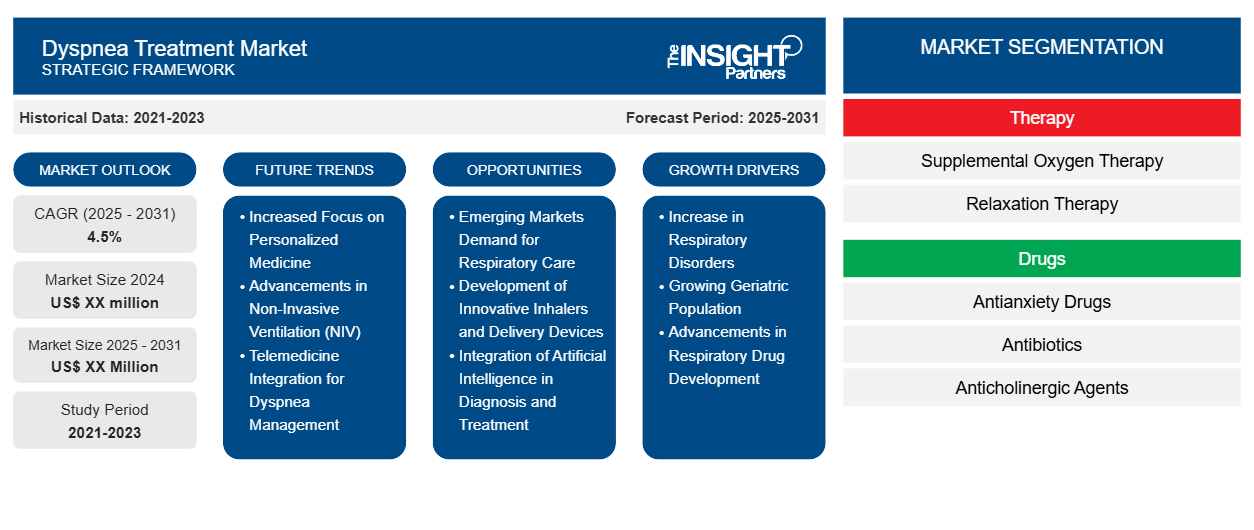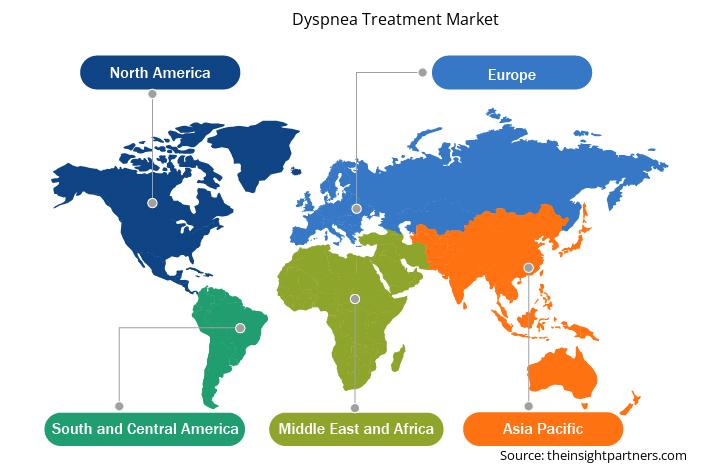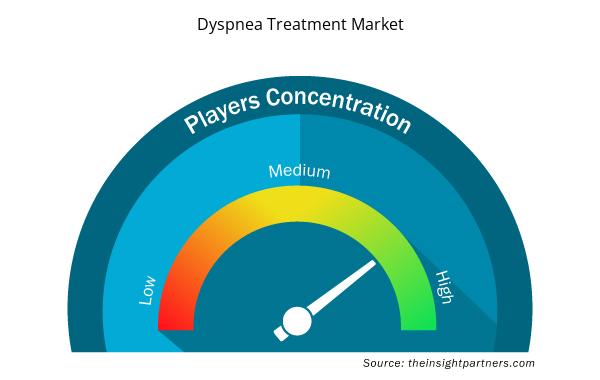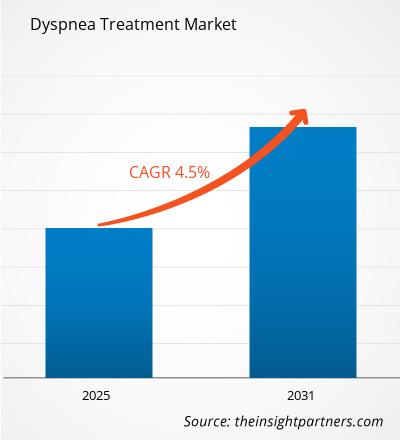The Dyspnea Treatment Market is expected to register a CAGR of 4.5% from 2025 to 2031, with a market size expanding from US$ XX million in 2024 to US$ XX Million by 2031.
The report is segmented by Therapy (Supplemental Oxygen Therapy, Relaxation Therapy). The report further presents analysis based on the Drugs (Antianxiety Drugs, Antibiotics, Anticholinergic Agents, Corticosteroids, Others), End Users (Hospitals, Home Care, Specialty Centres). The global analysis is further broken-down at regional level and major countries. The Report Offers the Value in USD for the above analysis and segments.
Purpose of the Report
The report Dyspnea Treatment Market by The Insight Partners aims to describe the present landscape and future growth, top driving factors, challenges, and opportunities. This will provide insights to various business stakeholders, such as:
- Technology Providers/Manufacturers: To understand the evolving market dynamics and know the potential growth opportunities, enabling them to make informed strategic decisions.
- Investors: To conduct a comprehensive trend analysis regarding the market growth rate, market financial projections, and opportunities that exist across the value chain.
- Regulatory bodies: To regulate policies and police activities in the market with the aim of minimizing abuse, preserving investor trust and confidence, and upholding the integrity and stability of the market.
Dyspnea Treatment Market Segmentation
Therapy
- Supplemental Oxygen Therapy
- Relaxation Therapy
Drugs
- Antianxiety Drugs
- Antibiotics
- Anticholinergic Agents
- Corticosteroids
End Users
- Hospitals
- Home Care
- Specialty Centres
Customize This Report To Suit Your Requirement
You will get customization on any report - free of charge - including parts of this report, or country-level analysis, Excel Data pack, as well as avail great offers and discounts for start-ups & universities
Dyspnea Treatment Market: Strategic Insights

- Get Top Key Market Trends of this report.This FREE sample will include data analysis, ranging from market trends to estimates and forecasts.
Dyspnea Treatment Market Growth Drivers
- Increase in Respiratory Disorders: The rising prevalence of respiratory conditions such as chronic obstructive pulmonary disease (COPD), asthma, and pulmonary fibrosis is significantly driving the demand for dyspnea treatments. Dyspnea, or shortness of breath, is a common symptom of these conditions, leading to a heightened need for effective treatment options like bronchodilators, oxygen therapy, and mechanical ventilation.
- Growing Geriatric Population: With the global aging population, the incidence of age-related diseases such as heart failure, pneumonia, and COPD is on the rise, all of which contribute to dyspnea. As older adults are more susceptible to respiratory issues, the growing geriatric demographic is expected to increase the demand for effective treatments to alleviate dyspnea and improve quality of life.
- Advancements in Respiratory Drug Development: Ongoing innovations in respiratory drug therapies, including inhalers, nebulizers, and combination therapies, are providing more targeted and effective treatments for dyspnea. New medications that reduce airway inflammation, improve lung function, and alleviate symptoms are expected to significantly drive market growth.
Dyspnea Treatment Market Future Trends
- Increased Focus on Personalized Medicine: There is a growing trend toward personalized treatment approaches for dyspnea, particularly in the management of underlying chronic respiratory diseases. Targeted therapies based on patient-specific genetic profiles and biomarkers are enabling better outcomes and reducing the risk of side effects, boosting the demand for customized dyspnea treatments.
- Advancements in Non-Invasive Ventilation (NIV): Non-invasive ventilation (NIV) devices, such as continuous positive airway pressure (CPAP) and bilevel positive airway pressure (BiPAP) devices, are gaining popularity in the dyspnea treatment market. These devices help alleviate breathing difficulties in patients with COPD, congestive heart failure, and sleep apnea, contributing to improved clinical outcomes and patient comfort.
- Telemedicine Integration for Dyspnea Management: The integration of telemedicine and digital health technologies for remote monitoring of respiratory function is a growing trend in dyspnea treatment. Wearable devices and mobile apps are enabling continuous monitoring of lung function, allowing healthcare providers to adjust treatments in real time and improving patient management.
Dyspnea Treatment Market Opportunities
- Emerging Markets Demand for Respiratory Care: As healthcare infrastructure improves in emerging markets like Asia-Pacific, Latin America, and Africa, there is a growing opportunity for companies to expand their dyspnea treatment offerings. Increasing awareness of respiratory diseases and the availability of affordable treatment options will drive market growth in these regions.
- Development of Innovative Inhalers and Delivery Devices: The development of new-generation inhalers and drug delivery systems, such as dry powder inhalers and nebulizers with enhanced drug formulations, offers opportunities to improve treatment efficacy for dyspnea. These innovations are crucial for patients with chronic respiratory diseases who require frequent treatments.
- Integration of Artificial Intelligence in Diagnosis and Treatment: AI-driven tools for early detection and personalized treatment plans are an emerging opportunity in the dyspnea treatment market. AI can assist in the accurate diagnosis of underlying causes of dyspnea and predict patient responses to specific treatments, leading to improved outcomes and more efficient healthcare delivery.
Dyspnea Treatment Market Regional Insights
The regional trends and factors influencing the Dyspnea Treatment Market throughout the forecast period have been thoroughly explained by the analysts at Insight Partners. This section also discusses Dyspnea Treatment Market segments and geography across North America, Europe, Asia Pacific, Middle East and Africa, and South and Central America.

- Get the Regional Specific Data for Dyspnea Treatment Market
Dyspnea Treatment Market Report Scope
| Report Attribute | Details |
|---|---|
| Market size in 2024 | US$ XX million |
| Market Size by 2031 | US$ XX Million |
| Global CAGR (2025 - 2031) | 4.5% |
| Historical Data | 2021-2023 |
| Forecast period | 2025-2031 |
| Segments Covered |
By Therapy
|
| Regions and Countries Covered | North America
|
| Market leaders and key company profiles |
Dyspnea Treatment Market Players Density: Understanding Its Impact on Business Dynamics
The Dyspnea Treatment Market market is growing rapidly, driven by increasing end-user demand due to factors such as evolving consumer preferences, technological advancements, and greater awareness of the product's benefits. As demand rises, businesses are expanding their offerings, innovating to meet consumer needs, and capitalizing on emerging trends, which further fuels market growth.
Market players density refers to the distribution of firms or companies operating within a particular market or industry. It indicates how many competitors (market players) are present in a given market space relative to its size or total market value.
Major Companies operating in the Dyspnea Treatment Market are:
- GlaxoSmithKline
- Novartis
- Merck & Co.
- Boehringer Ingelheim
- AstraZeneca
- Teva Pharmaceuticals
Disclaimer: The companies listed above are not ranked in any particular order.

- Get the Dyspnea Treatment Market top key players overview
Key Selling Points
- Comprehensive Coverage: The report comprehensively covers the analysis of products, services, types, and end users of the Dyspnea Treatment Market, providing a holistic landscape.
- Expert Analysis: The report is compiled based on the in-depth understanding of industry experts and analysts.
- Up-to-date Information: The report assures business relevance due to its coverage of recent information and data trends.
- Customization Options: This report can be customized to cater to specific client requirements and suit the business strategies aptly.
The research report on the Dyspnea Treatment Market can, therefore, help spearhead the trail of decoding and understanding the industry scenario and growth prospects. Although there can be a few valid concerns, the overall benefits of this report tend to outweigh the disadvantages.
- Historical Analysis (2 Years), Base Year, Forecast (7 Years) with CAGR
- PEST and SWOT Analysis
- Market Size Value / Volume - Global, Regional, Country
- Industry and Competitive Landscape
- Excel Dataset


- Online Exam Proctoring Market
- Batter and Breader Premixes Market
- Identity Verification Market
- Procedure Trays Market
- Small Internal Combustion Engine Market
- Aircraft Wire and Cable Market
- Occupational Health Market
- Single Pair Ethernet Market
- Aesthetic Medical Devices Market
- Print Management Software Market

Report Coverage
Revenue forecast, Company Analysis, Industry landscape, Growth factors, and Trends

Segment Covered
This text is related
to segments covered.

Regional Scope
North America, Europe, Asia Pacific, Middle East & Africa, South & Central America

Country Scope
This text is related
to country scope.
Frequently Asked Questions
The rise in respiratory disorders, an aging population, and advancements in drug delivery technologies and non-invasive treatments are the primary drivers of the dyspnea treatment market.
Personalized medicine allows for tailored treatment regimens based on a patient's unique genetic makeup, improving the effectiveness and reducing side effects of treatments for conditions causing dyspnea, thereby boosting market demand.
Challenges include limited awareness in some regions, the complexity of diagnosing the underlying causes of dyspnea, and the need for continuous innovation in drug delivery systems to enhance patient compliance.
NIV devices, such as CPAP and BiPAP, provide a non-surgical option for managing dyspnea, particularly in patients with COPD and heart failure. They improve patient comfort, reduce hospital stays, and support better clinical outcomes, driving market growth.
Telemedicine platforms enable remote monitoring of respiratory function, allowing healthcare providers to make timely adjustments to treatment plans, thus improving patient care and outcomes in managing dyspnea.
Increasing healthcare access, rising awareness of respiratory diseases, and the growing demand for affordable treatments in emerging markets offer significant growth opportunities for companies specializing in dyspnea treatment solutions.
Trends and growth analysis reports related to Life Sciences : READ MORE..
- GlaxoSmithKline
- Novartis
- Merck & Co.
- Boehringer Ingelheim
- AstraZeneca
- Teva Pharmaceuticals
- Meda Pharmaceuticals
- Pulmonx Corporation
- Philips Healthcare
- ResMed.

 Get Free Sample For
Get Free Sample For